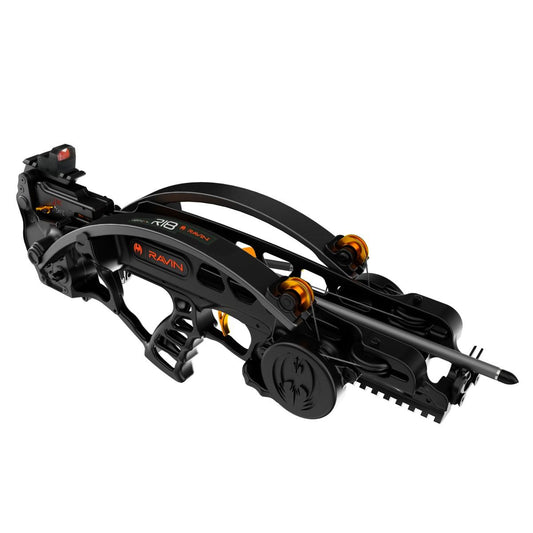

Ravin R18 Takedown Crossbow offers a compact design with an overall length of just 25 inches, making it the shortest model in its lineup. This crossbow features the innovative VertiCoil Cam System, allowing for an impressive axle-to-axle height of only 1.3 inches when cocked. With a draw weight of 250 pounds and a velocity of 330 feet per second, it delivers powerful performance for various hunting scenarios. Weighing just 6 pounds, the R18 is lightweight and user-friendly, perfect for both beginners and experienced hunters.
Equipped with a built-in cocking mechanism and a Ravin 3-Dot Reflex Sight, target acquisition is fast and efficient. The detachable stock and quiver enhance portability and convenience, allowing quick adjustments when on the move. With a power-stroke of 13 inches and kinetic energy of 85 ft-lbs, this crossbow is designed for precision and accuracy, making it suitable for both tactical applications and recreational use.
Key Features:
- VERTICOIL CAM SYSTEM for a compact axle-to-axle height of 1.3 inches when cocked, enhancing maneuverability.
- VERSA-DRAW COCKING SYSTEM featuring an ambidextrous design that requires only 12 pounds of force to cock, making it easy for all users.
- TRAC-TRIGGER FIRING SYSTEM ensures straight-line nock travel, providing improved accuracy with every shot.
- FRICTIONLESS FLIGHT SYSTEM eliminates friction for consistent performance and longer lifespan of strings and cables.
- POWER AND SPEED with a velocity of 330 FPS, delivering high energy for effective hunting.
- DETACHABLE STOCK/QUIVER for flexibility and ease during transport or storage.
- PRECISION ASSEMBLY means the R18 is fully assembled and pre-tuned for optimal performance right out of the box.
- SAFETY FEATURES including anti-dry fire and auto safety ensure a secure shooting experience.
Technical Specifications
| Specification | Value |
|---|---|
| FPS (Feet per Second) | 330 |
| Weight | 6 lbs |
| Length (Without Stock) | 18" |
| Length (With Stock) | 25" |
| Height Axle to Axle (Cocked) | 1.3" |
| Height Axle to Axle (Uncocked) | 4.1" |
| Overall Width | 4.75" |
| Power-Stroke | 13" |
| Kinetic Energy | 85 ft-lbs |
| Draw Effort | 12 lbs |
| Draw Weight | 250 lbs |
| Cam System | VertiCoil |
| Stock/Quiver | Detachable |
| Assembly | Fully Assembled/Pre-Tuned |
| Arrows | 3 - 16" .003 350 Grain R18 Arrows with Field Points |
| Draw Handle | 1 - Removable |
| Sight | Ravin 3 Dot Reflex Sight |
| Cocking Mechanism | Built-In |
| Safety Features | Anti-Dry Fire/Auto Safety |
What's in the Box?
- Ravin R18 Takedown Crossbow
- Ravin 3-Dot Reflex Sight
- 3 - 16" .003 350 Grain R18 Arrows with Field Points
- Removable Draw Handle
- Detachable Stock and Quiver
- User Manual
Customer Reviews
"The R18 is incredibly easy to handle and packs a punch. Perfect for my hunting trips!"
"Lightweight and compact, this crossbow fits right in my backpack. I love the adjustable stock!"
"The accuracy is unmatched. I hit my target every time with the Ravin 3-Dot Sight!"
FAQ
What is the effective range of the Ravin R18?
The effective range of the Ravin R18 is generally around 40 to 50 yards for optimal accuracy. However, skilled users can extend this range with practice and familiarity with the crossbow.
How do I maintain the Ravin R18 Crossbow?
Regular maintenance includes checking the string for wear, applying wax to prolong its life, and ensuring the limbs and cams are functioning correctly. Cleaning the sight and keeping the crossbow dry also contribute to its longevity.
How does the R18 compare to other Ravin models?
Compared to other Ravin models, the R18 is designed for compactness and portability, making it ideal for tight hunting spots. Other models might offer higher speeds or different features, so consider your specific needs when choosing.
Similar Models
Looking for more options? Explore our full range of Ravin crossbows, including the Ravin R20 for enhanced speed and the Ravin R29 for superior accuracy. Each model is designed to meet different hunting needs, ensuring you find the perfect fit for your adventures.
You May Also Like
Here’s some of our most similar products people are buying. Click to discover trending style.











